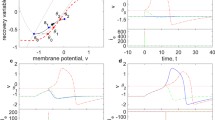Abstract
several ways of estimating a continuous function from the spike train output of a neuron subjected to repeated stimuli are compared: (i) the probability of firing function estimated by a PST-histogram (ii) the rate of discharge function estimated by a “frequencygram” (Bessou et al. 1968) and (iii) the interspike-interval function which is introduced in this paper. For a special class of neuronal responses, called deterministic, these functions may be expressed in terms of each other. It is shown that the current clamped Hodgkin-Huxley model of an action potential encoding membrane (Hodgkin and Huxley 1952) is able to generate such deterministic responses. As an experimental example, a deterministic response of a primary muscle spindle afferent is used to demonstrate the estimation of the functions. Interpretability and numerical estimatability of these spike train describing functions are discussed for deterministic neuronal responses.
Similar content being viewed by others
References
Bessou P, Laporte Y, Pagès B (1968) A method of analysing the response of spindle primary endings to fusimotor stimulation. J Physiol 196:37–45
Gerstein GL, Kiang NYS (1960) An approach to the quantitative analysis of electrophysiological data from single neurons. Biophys J 1:15–28
Hodgkin AL, Huxley AF (1952) A quantitative description of membrane current and its application to conduction and excitation in nerve. J Physiol 117:500–544
Holm W, Padeken D, Schäfer SS (1981) Characteristic curves of the dynamic response of primary muscle spindle endings with and without gamma stimulation. Pflügers Arch 391:163–170
Hulliger M, Prochazka A (1983) A new simulation method to deduce fusimotor activity from afferent discharge recorded in freely moving cats. J Neurosci Methods 8:197–204
Marmarelis PZ, Marmarelis VZ (1978) Analysis of physiological systems: the white-noise approach. Plenum Press, New York
Moore GP, Perkel DH, Segundo JP (1966) Statistical analysis and functional interpretation of neuronal spike data. Ann Rev Physiol 28:493–522
Perkel DH, Gerstein GL, Moore GP (1967) Neuronal spike trains and stochastic point processes. I. The single spike train. Biophys J 7:391–418
Poppele RE, Bowman RJ (1970) Quantitative description of linear behavior of mammalian muscle spindles. J Neurophysiol 33:59–72
Sakuranaga M, Shunsuke S, Naka KI (1986) Nonlinear analysis: mathematical theory and biological applications. CRC Crit Rev Biomed Eng 14:127–184
Author information
Authors and Affiliations
Rights and permissions
About this article
Cite this article
Awiszus, F. Continuous functions determined by spike trains of a neuron subject to stimulation. Biol. Cybern. 58, 321–327 (1988). https://doi.org/10.1007/BF00363941
Received:
Issue Date:
DOI: https://doi.org/10.1007/BF00363941




